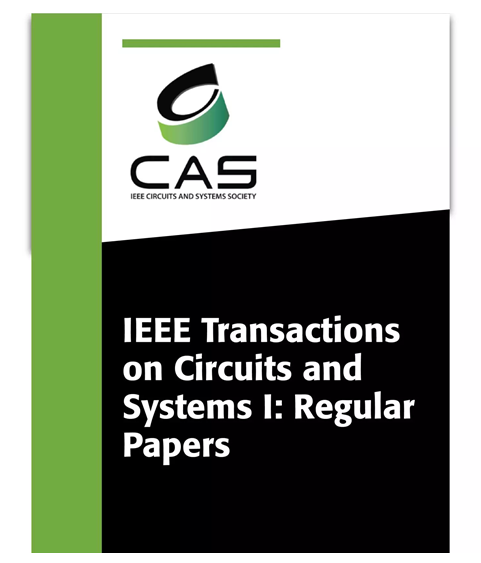FALSAx: An Integrated Framework for Accuracy and Logic Synthesis Estimation of Approximate Adders
IF 5.2
1区 工程技术
Q1 ENGINEERING, ELECTRICAL & ELECTRONIC
IEEE Transactions on Circuits and Systems I: Regular Papers
Pub Date : 2024-12-19
DOI:10.1109/TCSI.2024.3511383
引用次数: 0
Abstract
This work proposes an integrated framework for accuracy and logic synthesis (LS) estimation of approximate adders (FALSAx). It represents a versatile and robust framework designed to estimate the accuracy, power, and area of various approximate adders (AxAs) for any input width (W) and K bits of approximation using machine learning (ML) models. FALSAx facilitates performance predictions and optimization for different AxAs configurations through meticulously curated datasets and ML-driven analysis. The framework’s capability to automatically generate Pareto fronts from estimated values aids in identifying optimal trade-offs among crucial metrics, providing essential insights for circuit design and optimization. The FALSAx includes four internal frameworks: FrAQ, PILSE, and FELSE, which estimates dynamic power, total leakage power, and area, with frequency variations automatically, and the FALED dataset of the FALSAx. As a case study, this work analyzed 16 types of AxAs on FALSAx: AMA-V, AxPPA, COPY, TRUNC, ETA, LOA, HOERAA, LDCA, LZTA, HEAA, M-HEAA, HERLOA, M-HERLOA, HOAANED, OLOCA, and SETA. The rigorous analysis provided by FALSAx revealed that HERLOA, M-HERLOA, M-HEAA, and AxPPA demonstrated superior accuracy metrics such as SSIM, NCC, MAE, and MRE. Furthermore, power analysis showed that AxPPA exhibited the best power efficiency for lower approximation bits (近似加法器精度和逻辑综合估计的集成框架
本工作提出了一个用于近似加法器(FALSAx)的精度和逻辑综合(LS)估计的集成框架。它代表了一个通用且强大的框架,旨在使用机器学习(ML)模型估计任何输入宽度(W)和K位近似的各种近似加法器(axa)的精度,功率和面积。FALSAx通过精心策划的数据集和ml驱动的分析,促进了不同AxAs配置的性能预测和优化。该框架能够根据估计值自动生成帕累托前沿,有助于识别关键指标之间的最佳权衡,为电路设计和优化提供必要的见解。FALSAx包括四个内部框架:FrAQ、PILSE和FELSE,它们可以自动估计动态功率、总泄漏功率和面积,并自动进行频率变化,以及FALSAx的FALED数据集。作为案例研究,本文分析了FALSAx上的16种axa: AMA-V、AxPPA、COPY、TRUNC、ETA、LOA、HOERAA、LDCA、LZTA、HEAA、M-HEAA、HERLOA、M-HERLOA、hoahan、OLOCA和SETA。FALSAx提供的严格分析显示,HERLOA、M-HERLOA、M-HEAA和AxPPA具有优异的准确度指标,如SSIM、NCC、MAE和MRE。此外,功率分析表明,AxPPA在较低近似比特上具有最佳的功率效率($K \leq 3$)。同时,像COPY、TRUNC、AMA-V、LDCA和LZTA这样的无门加法器对于更高的近似位更节能($K \gt 3$)。面积估计表明,AxPPA在较低的近似比特上保持竞争效率($K \leq 5$),而TRUNC和LDCA在较高的比特上更有效($K \gt 5$)。
本文章由计算机程序翻译,如有差异,请以英文原文为准。
求助全文
约1分钟内获得全文
求助全文
来源期刊
CiteScore
9.80
自引率
11.80%
发文量
441
审稿时长
2 months
期刊介绍:
TCAS I publishes regular papers in the field specified by the theory, analysis, design, and practical implementations of circuits, and the application of circuit techniques to systems and to signal processing. Included is the whole spectrum from basic scientific theory to industrial applications. The field of interest covered includes: - Circuits: Analog, Digital and Mixed Signal Circuits and Systems - Nonlinear Circuits and Systems, Integrated Sensors, MEMS and Systems on Chip, Nanoscale Circuits and Systems, Optoelectronic - Circuits and Systems, Power Electronics and Systems - Software for Analog-and-Logic Circuits and Systems - Control aspects of Circuits and Systems.

 求助内容:
求助内容: 应助结果提醒方式:
应助结果提醒方式:


